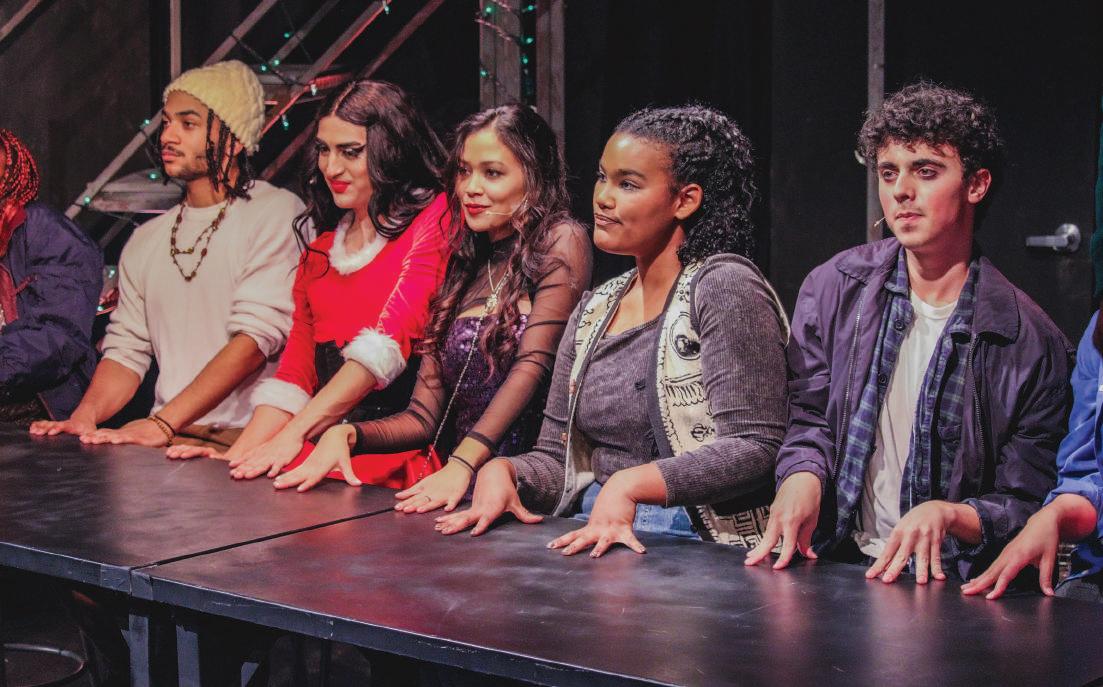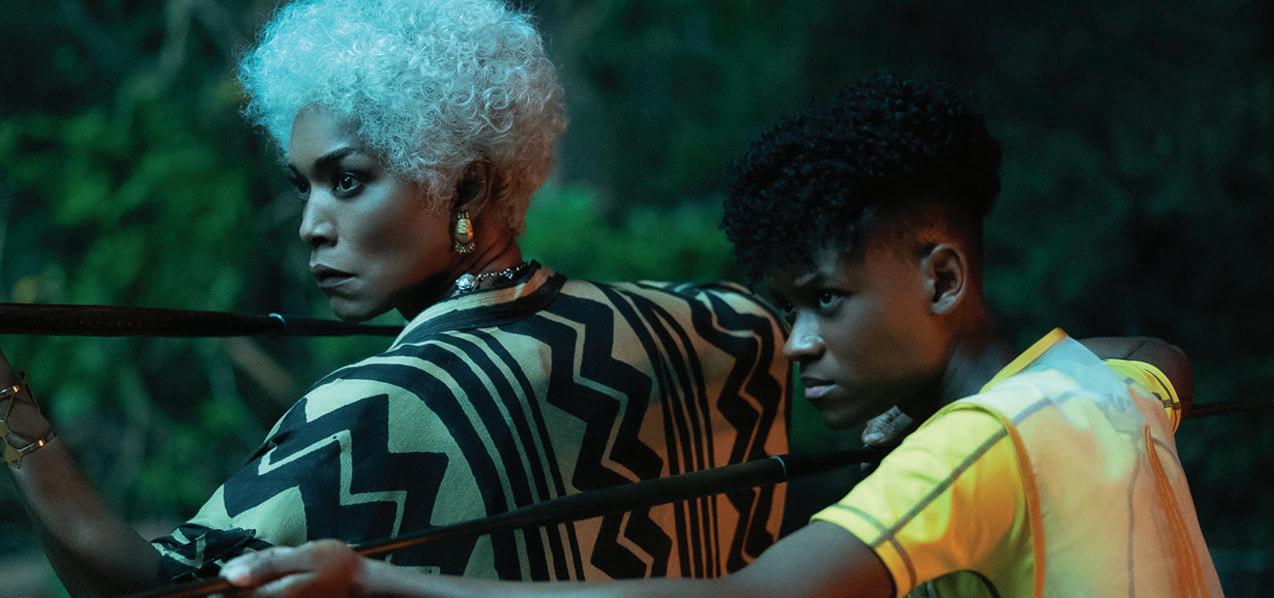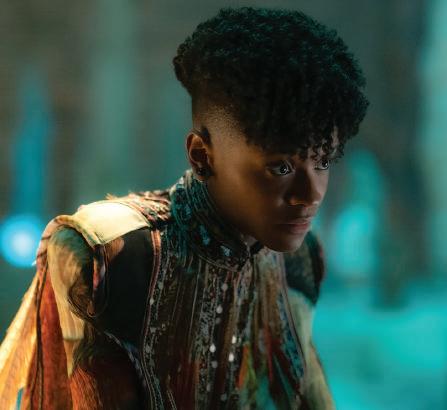Falling Into Georgetown’s Theater Scene
 Hoya Staff Writers
Hoya Staff Writers


 Hoya Staff Writers
Hoya Staff Writers

Students performed ‘Rent,’ ‘Dog Act’ and ‘Love’s Labour’s Lost’ to eager audiences in an impressive showcase of talent, work ethic and creativity.
Eileen Miller and Bettina Bottome Hoya Staff WritersAcross Georgetown University’s campus, in ven ues large and small, students and faculty have been hard at work painting sets, warming up their voices, running through lines and sourcing costumes, put ting countless hours into mounting numerous theater productions. Three of these fall productions — “Rent,” “Dog Act,” and “Love’s Labour’s Lost” — ex emplify the dedication of their casts and crews.
Through three wildly different stories –– a rock musical depicting the struggles and joys of a group of New York City artists living amid the AIDS pandem ic, a troupe of vaudevillians trekking across the apoc alyptic wilderness, and a lighthearted comedy about three friends who try (and fail) to swear off women to focus on their studies — these shows prove how
important art and theater are for representing and understanding our current moment.
“Rent,” the groundbreaking and iconic 1996 rock musical that won four Tony awards and ran on Broadway for over a decade, found a new home this year on the Hilltop.
“Rent,” which is being put on by Georgetown’s Nomadic Theatre, a student theater organization whose tagline is “socially engaged and technically ambitious productions,” opened Nov. 10 and will run through Nov. 19.

Director Olivia Martin (COL ’23) said that in her application to direct for Nomadic Theatre, “Rent” was her top choice for the show she wished to direct. “Rent” had been a favorite of Martin’s from a young age because of how it provided her with a story about
people who reflected her own identities.
“It was one of the first times I felt really connected to a piece of media and felt like I saw myself in it somehow,” Martin told The Hoya. “It was telling queer stories, but because those stories were being told in a way that felt accessible to me.”
The importance of “Rent” and its representation for underrepresented groups including people of color and the LGBTQ+ community, as well as people with intersecting identities, resonated with other members of the cast as well.
Caitlin Frazier (COL ’23), who played the role of Joanne, said that the show’s diverse cast made her feel at home in the production in a way she hadn’t felt in previous shows.
“Georgetown theater is a very white place, and I honestly had a really tough time with the white plays at the end of last year, as a lot of people did,” Frazier
MIRANDA XIONG/THE HOYA
On Nov. 10, Georgetown’s Nomadic Theatre — a student-run theater organization — opened its production of “Rent,” an iconic 1996 rock musical that won four Tony awards and changed the landscape of musical theater.

told The Hoya
Frazier said the show’s diverse cast of characters and history of casting people of color and LGBTQ+ actors for its roles translated to Nomadic Theatre’s casting process as well.
“‘Rent’ is usually cast very diverse, and that has been met to a T in this production,” Frazier said.
Allie Gaudion (COL ’26), assistant director for “Rent,” said the production took the responsibility of diversity and representation seriously.
“We have a dramaturgy team, and their job was to do a lot of research on the time period and the sub ject matter. We were all aware of the sort of struggles that [the LGBTQ+ community] was going through based on their researcth,” Gaudion told The Hoya.
Gaudion found that the freedom of a student-run production was especially beneficial for the story that “Rent” tells.
“It’s important that we all have a space to share [our experiences] in this unique way and be able to have control over it ourselves, instead of having to fil ter it through some other Georgetown Catholic lens,” Gaudion said.
Martin said it was beautiful to see students from marginalized identities taking center stage at Georgetown.
“There’s these sort of beats of pure, absolute, in your face, we’re here and we exist, and it’s so nice to see queer people play those beats. And I think that’s been a real joy for all of us, for me and for the actors,” Martin said.
“Dog Act” is a play that, according to lead actor Jake Teall (COL ’23), is “a fun journey, a way to laugh, something that’s really weird. It’s kind of ridiculous, but once people get past their preconceptions, it’s a really, really fun play to watch, and to be a part of.”
“Dog Act,” written by playwright Liz Duffy Adams, was the first show in the Davis Performing Arts Cen ter 2022-23 Theater and Performance Studies Home season, titled “(W)RIGHT TO BE HUMAN,” running from Nov. 2 to 12.
The department of performing arts brought on Holly Twyford, one of Washington, D.C.’s most famous directors and actors, as a guest di rector for the production.
Under her direction, the cast and crew brought to life the post-apocalyptic, yet funny and heartwarm ing world of “Dog Act,” which follows the characters of Rozetta “Zetta” Stone and her companion, Dog, two story-telling vaudevillians, as they travel across the desolate and destroyed North American conti nent, headed towards China.

For Anna Dewey (COL ’26), who played the lead role of Rozetta Stone, it was her first interac tion with Holly Twyford that revealed the growth and community she would experience while working on the show.
“I did my monologue and not only did she give me feedback, but helped me, and we worked through my monologue, which isn’t really what you normally do in an audition,” Dewey told The Hoya.
Teall, who played the character known as “Dog,” found that working with Twyford was an incredible learning opportunity.
“When you’re working with other students, we’re all figuring it out together. Whereas [Twyford] has some really good tricks that she’s found along the way that really work. Being able to implement that into our own processes as actors has been really help ful,” Teall said in an interview with The Hoya. “I think it takes it to a new level.”
Professor Natsu Onoda Power, who worked dou ble duty on “Dog Act” as both the artistic director of the Davis Center and as the show’s set designer, was able to provide valuable mentorship for students separate from academic life, according to Twyford.
“You’re not being directed by people who are also grading you and are also professors that you have outside relationships with. So the director-actor rela tionship with a guest artist is very different from the director-actor relationship with a faculty member or a student director,” Onoda Power told The Hoya. “It’s its own unique relationship that is worth having.”
For Dewey, the themes ingrained within the postapocalyptic setting of the show evoke social issues that populate news headlines today.
“There’s elements of climate change and tyranny and warfare because these sort of horrible things have had to happen in order for this apocalypse to occur,” Dewey said.
Onoda Power used images of plastic wasteland and the Fukushima disaster as the inspiration for the set. She found images from Fukushima to strike at the heart of the setting of “Dog Act.”
“Contemporary events like that really resonated with me and with the play,” Onoda Power said. “Es pecially in seeing people trying to thrive and live in an environment that’s been completely destroyed.”
Teall also found that “Dog Act” dealt with themes of dealing with isolation through community, which he found related to the Georgetown population and college students in general.

“In the play, everyone is choosing who they con sider their family. On a college campus, a lot of people are not living with their blood relatives. We’re choos ing our family like the characters,” Teall said.
For Dewey, the biggest challenge of her role in “Dog Act” was parsing out the complicated
language of her character.
“Instead of binding contract, I say blinding con tract or snowed up instead of showed. I think get ting all those little discrepancies in my head and remembering them the incorrect way was a chal lenge,” Dewey said.
Teall also found acting out the script to be a chal lenge due to both the extreme level of detail of the script and the high-stakes elements of the plot.
“My character has an action that allows a thou sand people to die. I personally can’t tie back a direct action where I have caused people to die, so work ing together with my scene partners to create the weight of that has been really challenging, but very fulfilling,” Teall said.
The challenge was ultimately rewarding, as the cast and crew were able to create a “Dog Act” that, ac cording to Teall, was enjoyable while also encourag ing the audience to ponder deep questions about life.
“It was meaningful and valuable and asked a lot of questions while also having a rehearsal process that’s fulfilling and fun,” Teall said.
A lesser-known Shakespearean comedy with a 20th century — and Georgetown-centric — twist, running from Oct. 27 to Nov. 5, “Love’s Labour’s Lost,” William Shakespeare’s ninth play, was performed at Poulton Hall by Mask and Bauble, one of George town’s many student theater organizations.
The comedy, which centers around three noble men who agree to swear off women for three years to focus on their studies, was adapted to the set ting of Georgetown in the 1960s. The noblemen become college students, and their vow is tested by the introduction of women to the university. This was borrowed from Georgetown’s own history, as Georgetown College first began accepting female students in the 1960s.
Scott Burke (COL ’26) played the role of Berowne, one of the trio of students who initially chafes against the pact. Later, along with his friends, Berowne fails to hold up his promise. The discomfort that this situ ation produces was one of the main reasons Mask and Bauble chose to adapt the play.
Burke said that Mask and Bauble chose to set the play at Georgetown — rather than its usual setting of 16th-century Spain — after noticing how the ten sion between love and studying that was a central theme of the play also applied to the modern day university setting.
“Obviously today there aren’t students swearing oaths not to date women in college, but there’s still that tension that is very real at academically rigorous universities like Georgetown, where you want to fo cus on your studies, but yes, there are more things in life than just studying,” Burke told The Hoya
Sasha Montefiore (COL ’25), who played the role of Armado — a courtier who falls hopelessly in love with the character Jaquenetta who is in love with another — said Shakespeare brought out complex ities in the text.
Burke said the language of Shakespeare was a barrier for the cast initially, but once they had gotten comfortable with it, they were able to appreciate the power of the words and use it to their advantage in their performances.
COURTESY GEORGETOWN UNIVERSITYThe poster for ‘Dog Act,’ — which starred Jake Teall (COL ’23) and brought a light hearted spirit to this semes ter’s on-campus plays — was a welcome challenge for the actors involved.
“There are tools within the text that you can use as well to help inform your acting choices,” Burke said.
Burke studied the rhyme of his lines and dissected meter changes to help him prepare for his perfor mance — which included the longest speech in all of Shakespeare’s works.
“You have this really immensely powerful tool at your disposal, and it’s your job to let those words speak for that,” Burke said.
He also discussed specifically how he stud ied the rhyme and meter of the text to help him make acting decisions.
“‘Love’s Labour’s Lost’ I think has the highest ratio of rhymed verse to unrhymed verse of any Shake spearean comedy or play, and that means the rhyme is really important, and in rhyme, there’s meter. And when the meter changes, that means something. So there are tools within the text you can use as well to inform your acting choices,” Burke said.
Montefiore said that the opportunity to put on a performance in Riggs Library led the actors to perform in new ways. With only two hours to re hearse in the new environment before perform ing there, the cast was energized to put on their best performance possible.
“Doing it in the same place, it gets repetitive – [the performance] revitalized it, I definitely got a lot more energy from doing that, which pushed me into the next week of performances,” Montefiore said.
Being in the new performance space also in spired the actors to engage with each other in new
ways, as interacting in the new space made their performances feel more honest and natural. New acting choices were made as well, including one actor’s impromptu choice to read a letter directly to an audience member, which was adopted to be used in the following few performances.
“Samuel, who plays the king, he has this love letter that he’s reading to his mistress, out in the nowhere, and then he decided to read it to a girl in the front row, and that was a choice made in Riggs, inspired by Riggs, that we end ed up taking back and using in the rest of the production,” Burke said.
The new energy gained from performing at Riggs was evident to everyone in the cast, and they carried that energy with them to the rest of the show’s run.
“Paul, our director, said afterwards, ‘That’s so great, you were having so much fun with it. Let’s bring that to Poulton,’ and I think we did,” Montefiore said.
Although at the beginning of the process Burke and Montefiore described the atmosphere within the cast as stagnant and somewhat stiff, by the end they had become kin. Most of all, Montefiore appreci ated the friendships he built within the cast, which grew closer over the course of their long rehearsals and various performances.
“Being on stage is so unique, there is no other feeling like it really,” Montefiore said. “But it was actually the people who were the most fun for me. You get to know these people so, so well, so that was very special.”
Seeing the latest Marvel movie has become, in some respects, a mandatory exercise.
Each formulaic installment in the series of block buster action films has become a simple continua tion of the Marvel Cinematic Universe (MCU) narra tive itself, locking viewers into a cycle where buying a ticket to see the next episode of the story unfold is like replacing your iPhone after its updates stop be ing compatible three or four years after purchase.
But occasionally — like with “Black Panther” in 2018 — the latest MCU film ends up actually bust ing the block. The original “Black Panther” was not just a compelling film — it became a cultural mile stone of on-screen Black representation. Its marriage of beautiful costumes, crackling fight scenes and rel evant social commentary raised the bar so high that simply walking into a Marvel movie titled “Black Panther: Wakanda Forever” in 2022 holds a different weight than seeing yet another MCU film.
“Wakanda Forever” attempts to walk the same fine line that turned the original from commodity to culturally conscious art, all while grappling with the loss of star Chadwick Boseman, whose charac ter lent a kind-hearted aura to “Black Panther” that
carried that film at times.
“Wakanda Forever” comes close to succeeding. The film offers as poignant of a mourning space as an action movie can, while expanding the world building of Wakanda and highlighting new, power ful faces. As a sequel, however, it is plagued by MCU tropes that prioritize narrative brevity and digest ibility over detail and exposition.
The film acknowledges the public mourning for Boseman, making no attempt to replace his char acter T’Challa — the Black Panther and the king of Wakanda. Instead, it opens with a stirring funeral for T’Challa, featuring stunning visuals and costumes followed by the weighty silence of the Marvel intro graphic. The tribute to Boseman at the end is equally moving and delicate, and a soundtrack-filler Rihan na song becomes a genuinely cathartic moment dur ing her powerful vocal entrance in the credits.
“Wakanda Forever” has a plot also largely driven by T’Challa’s legacy and characters’ struggles with their loss. Wakanda has new leadership, spotlight ing Princess Shuri (Letitia Wright), who must come into her own — filling the shoes of the Black Panther while mourning her brother’s death.
Lovely performances from strong, charismatic female leads such as Wright, Angela Bassett, Danai Gurira, and Lupita Nyong’o are the highlight. Wright

captures Shuri’s internal conflict perfectly, conveying an affectingly unstable mixture of rage and grief. Bas sett and Gurira hold a compelling intensity through out, and Nyong’o brings a characteristic tenderness to every scene she appears in.

Otherwise, the plot of “Wakanda Forever” encap sulates the worst excesses of Marvel films.

Western hypocrisy concerning vibranium ex traction frames the story and connects with the backstory of the villain Namor (Tenoch Huerta), who witnessed colonial enslavement of Indig enous people. Namor, the king of Talokan, an aquatic Atlantis-esque nation, initially comes to Queen Ramonda (Bassett) for assistance because the United States is mining in its land for vibra nium. The interesting setting, however, is simply left as a vapid, politically safe comment.
Other than a drawn-out scene taking the viewer through the dark waters of Talokan, which fails to inspire because DC’s “Aquaman” has done it before, “Wakanda Forever” does not contain any real illus tration of the values or the culture of the Talokan.
Thus, the reason why Namor eventually feels that he is forced to choose violence over collaboration with the Wakandans is entirely unclear. Instead of exploring Western neocolonial legacies, the narra tive remains confined to surface-level talking points,
as the film simply pits Talokan against Wakanda for a relatively uncomplicated fight.
Moreover, in true Marvel fashion, the runtime is needlessly bloated by subplots. “Wakanda Forever” clocks in at two hours and 41 minutes — 12 min utes longer than “Avengers: Infinity War” — but without the star-studded 20-plus superhero lineup or the part where the plot took its characters to the ends of the universe and back.
Martin Freeman’s frequent interludes as CIA agent Everett Ross also do not move the story for ward in any meaningful way. Vibranium-detecting MIT student Riri Williams (Dominique Thorne) has potential as a character, but is quickly reduced to a one-dimensional quirky sidekick.
Overall, the movie does fulfill all the requirements of any Marvel fan wishing to see a familiar, univer sally appealing Marvel film. The futuristic yet natural sheen of Wakanda is ever-present, the special effects are brilliant, and in the end, viewers are left with more questions that will make them flock back to theaters for future Marvel films.
But a lackluster storyline holds back director Ryan Coogler and the supremely talented cast from recre ating the same magic that occurred four years ago. “Wakanda Forever” ultimately cannot transcend its blockbuster action movie packaging.
@THEBLACKPANTHER/TWITTER“Wakanda Forever” offers a compelling portrait of grief in the wake of Chadwick Boseman’s untimely death, despite being bogged down by needless subplots.
I adore horror. I love the imagery, the gutwrenching frights and the creativity that arises out of a cinematic obsession with fear. While other genres descend into monolithic voids of originality, horror consistently finds new ways to flip the script. After all, what is trite can never be terrifying.
As such, I find it disappointing that very little horror content is geared toward younger audiences. Obviously, children shouldn’t be watching “Saw II,” but they deserve to have a few spooky experiences of their own. Thankfully, though rare, there are some made-for-kids films that are undeniably influenced by the horror tradition. Such films push the boundaries of the Motion Picture Association (MPA) and are suffused with genuine scares and a wellcrafted atmosphere, just like “Coraline” from 2009.
Directed by Henry Selick — known for “The


Nightmare Before Christmas” — and based on a Neil Gaiman novella by the same name, “Coraline” follows the titular Coraline Jones (Dakota Fanning) — a precocious, cerulean-haired youth who is homesick for Michigan. Coraline, her mother Melanie (Teri Hatcher) and her father Charlie (John Hodgman) have just moved to Oregon and into the towering “Pink Palace,” a rickety apartment complex occupied by swarms of skittering cockroaches.
Separated from her hometown friends and dismissed by her workaholic parents, Coraline resigns herself to her miserable surroundings — that is, until she discovers a small hidden door in her apartment. The door leads to a parallel universe inhabited by idealized, button-eyed reflections of Coraline’s real parents.
These doppelgangers, dubbed “Other Mother” and “Other Father” are welcoming at first, but Coraline soon discovers that the Other Mother, who is actually an arachnid-like monster known as the Beldam, plans to trap her in the alternate reality forever, launching a ghost-filled, creeptastically crazy two-hour romp. I often find myself more unsettled by
“Coraline” than I perhaps ought to be by a children’s film. It’s animated, rated for all audiences and contains no gore or viscera. Despite all this, there’s still something about the movie that just gets to me.
Most basically, “Coraline” is visually unnerving. Rendered using a blend of stop motion and 3D animation techniques, Selick’s creation is both lifelike and lifeless, much like the parallel universe that Coraline encounters. At times, the animation is beautiful, dazzling the viewer with bright colors and smooth action. But in other moments, the natural jerkiness of stop motion enhances the already troubling images playing out across the screen.
In this way, Selick effectively taps into the uncanny valley by having his characters lunge about irregularly and leer at the viewer with their sewn-on gaze. The Other Mother is particularly threatening, becoming increasingly spider-like over the course of the film as she grows more and more fixated on Coraline, with her elongated limbs, hollow face and disturbing, insect-like movements.
Yet, the real horror of “Coraline” goes even deeper. As children, almost everyone is guilty of daydreaming
a little — constructing a version of reality where they do end up getting that toy, where everyone is friendly to them all of the time. Simply put, “Coraline” affirms this vision, inverting the daydream and revealing the dangers of a world built just for us.
Yeah, it probably would be a little creepy if everyone smiled all day every day. It most likely would not be such a good thing if our parents’ only commitment was to our individual happiness, regardless of the consequences. In a surprisingly mature turn for a children’s movie, “Coraline” attacks the basic building block of the young psyche — the dream — and finds terror in previously unexplored territory.
“Coraline” is a truly rare type of masterpiece, a horror film for the young that to this day strikes a chord with me. It is a monument to how horror could, and perhaps should, be for everyone, regardless of age. If you’re looking to revisit the dreams of the past and the nightmares they beget, you could do worse than “Coraline.”
William McCall is a sophomore in the College. Hoya Horror appears online and in print every other week.
This spin-off series of the classic movie “The Santa Clause” follows Tim Allen’s Santa Claus as he realizes he can’t be Santa forever. The six-ep isode series stars Tim Allen, Eric Lloyd and David Krumholtz and is available for streaming on Dis ney+ this week.



This sequel to the beloved 2007 romantic comedy “Enchanted” follows Amy Adams’ Giselle 10 years after her marriage to Patrick Dempsey’s Robert. The two reprise their roles as Giselle questions her happiness in the real world, upsetting her home of Andalasia in the process. The movie will be available for streaming on Disney+ on Nov. 18.

This comedy film starring Kristen Bell and Ben Platt is set during the lavish wedding of their es tranged half-sister. The film follows the family the week prior to the wedding as all of their drama is brought to light. The movie will be available on Amazon Prime Video on Nov. 18.
The hip-hop group announced their seventh studio album at Coachella 2022, revealing its name and reaffirming that this one will be their last. The album dropped Nov. 17, featuring smooth and sentimental singles such as the aptly-named “The Ending.”
When Dolores del Río stepped into the cam era frame, her eyes were impossible to look away from. Her cheekbones were perfectly angled toward the light, creating romance and intrigue with well-practiced skill. Perhaps more compelling, though, is her life story.
In her latest bio-fiction novel, “Miss del Río,” Georgetown University professor of Hispanic theater Bárbara Mujica brings Golden Age film star Dolores del Río into the spotlight with captivating prose and illuminating insight.
The intoxicating story is carefully nar rated by Mara, her fictional hairdresser and lifetime friend. Mujica utilizes this narrative framework to its advantage. Del Río’s side is often frustratingly flighty and shielded by

wealth from true hardship. Mara is utilized to stubbornly recount a grounded perspective, though at times the system results in a plot that expands quickly.
Central to the book is del Río’s ability adapt beyond a devastating miscarriage, madden ing husbands and rapidly changing times.
“They used to call her La Gatita, because she was like a cat. She always managed to land on her forepaws,” Mujica said about del Río at an on-campus event.
When del Río was a child, she and her fam ily fled to California as the Mexican Revolu tion advanced toward their estate. Despite her traditional family’s protestations, del Río’s dark eyes and sculpted cheekbones seemed to pull her to the movie industry al most involuntarily.
Del Río nimbly navigated the transition from
silent film towards talkies, which Mujica said was a major turning point in the media industry.
“Many many actors and actresses, whether or not they were foreigners, were frightened that audiences would find their voices ac ceptable or appealing,” she said.
Mujica’s book liberates del Río’s story from gossip rags and black and white films; she in stead becomes a vibrant icon. The strongest as pect of the novel is the careful stitching of histo ry and character. The reader is left with a deeper understanding of Golden Age film history as well as the connection to del Río. The bio-fiction genre suits Mujica’s scholarly background per fectly, and it is reflected in her writing.
Bio-fiction and scholarly work involve dif ferent types of research, according to Mujica.
“When you write a book like ‘Teresa de Avila, Lettered Woman,’ nobody ever asks
“Miss Del Rio,” a new biofiction novel by Georgetown professor Bárbara Mujica, beautifully explores the story of immigrant actress Dolores del Río.

you ‘What kind of undergarments were these nuns wearing?’” Mujica said. “But when you write a book like ‘Sister Teresa,’ you have to know that. You have to dress your character.”
In a post-event interview with The Hoya, Mujica said she wrote “Miss del Río” to high light the contribution of Mexican artists to American film.“When we think about Hol lywood and we think about Mexican im migration, we don’t think about these con tributions, and we don’t think about the tremendous role that these people played,” Mujica told The Hoya
However, del Río’s story of immigrant tri umph was shadowed by her public image as a blanket “foreigner” rather than a Mexican for much of her career. She played Russian and Native Hawaiian characters, amongst other roles, according to Mujica. This social disguise makes her identifier of “trailblazer” in “Miss del Río” uncomfortable.
“She succeeded by playing by the rules. She didn’t openly rebel in the way that, say, Frida did. She was marketed as a Spanish aristo crat,” Mujica said. “When interviewed, she always said that she was Mexican. But she didn’t fight with the marketing department, either. She knew what she had to do to get ahead, and she was smart with it.”
Her eventual return to Mexico, though, demonstrates how vital her heritage was in her identity. Del Río starred in Mexico’s first ever film to win the Grand Prix, now called the Palm d’Or, at the Cannes Film Festival. When Mara’s husband died overseas dur ing WWII, Mujica poignantly described the character’s grief in a standout scene from the novel. Mujica’s own personal history lent itself to writing about emotional collateral damage of war. Mujica said she is passion ate about veteran advocacy on Georgetown’s campus, driven by her own experiences of her son going to Iraq.
“In my work with the veterans, I met all kinds of veterans, veterans’ mothers, and veterans’ families. I know myself how stress ful it is to have a child in a warzone, and the amount of fear and stress that that produces,” Mujica said. “War affects people in all kinds of ways that don’t figure in the statistics.”
The book is a stirring story of a fascinating actress and the tumultuous time she lived in. Alongside her passion, Mujica’s careful research is evident in her work. “Miss del Río” is a must read.

Delicious breakfast foods and refreshing beverages abound at Butter Me Up, a Black-owned cafe with an allfemale staff nestled in D.C.’s Logan Circle.
 Maeve Pierson Hoya Staff Writer
Maeve Pierson Hoya Staff Writer
You cannot help but smile and appreciate life’s small joys when they walk into Butter Me Up at 14th Street in Logan Circle.

You will immediately notice heart-shaped bowls on tables decorated with champagne vas es full of flowers. The colorful wallpaper creates a playful space, and a U-shaped bar beneath a ceiling of succulents certainly helps the restau rant fulfill its mission of creating an experience “made to uplift” its customers.
Butter Me Up is a Black-owned and womencentered breakfast and lunch cafe employing an all-female staff. The restaurant began as a pop-up shop inside Founder and CEO Andre McCain’s HalfSmoke restaurant in Shaw, but it has since expanded to two brick-and-mor tar locations — both of which have added to the original menu, which consisted of solely breakfast sandwiches.
While breakfast sandwiches are not the only item on the menu, they are certainly where
Butter Me Up excels. Indulgent breakfast com binations shine, especially in dishes like the ap propriately named “Feels Like Home” breakfast sandwich, which consists of buttermilk fried chicken, soft scrambled eggs, caramelized on ions, smoked cheddar, sriracha mayo and dill pickles between a succulent brioche bun. Un surprisingly, the Washington Post named this sandwich one of the best fried chicken sand wiches in Washington, D.C.
Creating an award-winning breakfast sand wich doesn’t happen overnight. In its first year as a ghost kitchen out of HalfSmoke, Butter Me Up served 72,000 meals. A letter from District Mayor Muriel Bowser hangs on the wall at the restaurant’s 14th Street location, referencing the “astounding” accomplishment.
Butter Me Up’s carefully curated space and menu bring customers together to connect and relax, which somehow makes the food taste even better.
Furthermore, Butter Me Up sources many of its ingredients from local businesses. An es sential part of the restaurant’s mission in its
infancy was to uplift local vendors during the COVID-19 pandemic who may have been over looked, said McCain.
Butter Me Up continues to keep this mission at its core, sourcing ingredients from a plethora of local vendors including brioche rolls from Panorama Bakery, sage turkey sausage from Landover-based MeatCrafters, eggs from sev eral DMV farms and pickles from the District’s own Gordy’s Pickle Jar.
Despite the added cost of sourcing ingredi ents locally, McCain thinks this has contrib uted to the restaurant’s success — specifically the accomplishment of being named one of the best breakfast sandwiches. He says the ex pense is worth it because locally sourced prod ucts taste better.
Beyond indulgent sandwiches, the 14th Street location offers a variety of toasts, acai bowls, smoothies and shareable sides. The Sweet Potato Tots have a crispy exterior that contrasts the melt-in-your-mouth interior, and paired with a dollop of toasted marshmallow cream — it’s a dish reminiscent of the sweet
potato casserole many people will find on their tables in less than a week for Thanksgiving.
French toast sticks dusted with powdered sugar offer crisp, buttery edges and soft, cinna mony centers. Dip one in a heart-shaped dish of maple syrup, and it’s hard not to be transported back to the shameless enjoyment of eating fin ger foods as a child.
The restaurant also offers drinks to pair with breakfast. Colorful mimosas and other champagne-based cocktails emerge from the U-shaped bar, and silky lattes are prepared behind a quaint coffee counter. The Straw berry Acai Lemonade is a real star: aestheti cally pleasing with a strawberry nestled on the rim of the glass, the perfect combination of sweet and refreshing.
Consider Butter Me Up next time you are looking to try a new spot for brunch and are particularly craving a sandwich. In addition to its 14th Street location, Butter Me Up has an additional location in Montgomery Mall. It’s a must-try spot with ambiance and food that will surely uplift your spirits.
city and “gateway to the South” has created a distinct cultural climate that manifests itself in great food.
Noah Portner Guide ColumnistDear members of the Georgetown community: are you aware that Washington, D.C., is one of the best fusion food scenes in the world? Continuing my column on the theme of multiculturalism, this in stallment will be focused on food, a particularly fun aspect of culture mixing.
Last summer, I was walking down the street of San Francisco, Calif., with my grandparents — nearly starving to death — when I pulled up Yelp and had a revelation. Within a three-block radius, I could find food from every continent in a variety of styles: Egyp tian, Puerto Rican, Vietnamese, you name it!
It occurred to me that likely nowhere else in the world except the United States would this expansive, authentic food diversity take place. Multiculturalism has strengthened our country, and one way we all benefit from it is the massive diversity of cuisine. But this diversity is in no way unique to San Fran cisco. In fact, the District’s history as a cosmopolitan
From Black Americans arriving in D.C. during the Great Migration to the District’s large Vietnamese and Ethiopian communities, the food of D.C. reflects all the groups which left an imprint. Without further ado, here are some great D.C. fusion recommendations from my self, with the help of food columnist Audrey Biles.
Curry & Pie ($): First up on the list is a bit of a nobrainer. Close, affordable and pretty dang good, Georgetown’s Curry and Pie is too convenient not to miss. While it excels in classic Indian dishes (I’d recommend the Saag Paneer or the Chicken Tikka Masala), the restaurant’s eponymous “Pies” provide a South Asian twist on pizza, such as the mango chicken pie. Great for sharing, Curry & Pie pushes past being a simple Indian joint to deliver something truly original.
Susheria ($$): Another nearby specialty, this mod ernist joint offers a unique Japanese-Peruvian fusion in naturally tasting amalgams. As a lover of sushi and spice, Susheria hits the spot like no other cuisine, showcasing the distinct power of fusion food. Su sheria also marries classic Japanese rice bowls with Peruvian proteins (and spiciness) to create filling and
fascinating dishes.
Kaliwa ($$$): The third entry on this list comes from the rapidly revitalized Wharf — and sports not only two, but three cuisines in one place! Relying on the distinct flavor signatures of the Philippines, Thai land and Korea, Kaliwa specializes in turning out dishes classic to each nation with a twist. For a lover of Thai food such as myself, Kaliwa doesn’t shy away from flavor — each bite is a mouthwatering mixture of sweet, salty, tangy and spicy. From lumpia to pad thai to kimchi, this restaurant specializes in deliver ing foods that twist the new with the old.
Mariscos 1133 ($$): This Latin American seafood joint occupies a special place in my heart. While not inter-continental fusion, Mariscos’ distinct style is nevertheless hard to track down. Basically, Mariscos derives flavor from anywhere that speaks Spanish and touches water. The appetizers are shockingly good, with dishes like the octopus ceviche, lobster guacamole and queso fundido, and the large main dishes are nothing to sleep on either. The menu has a large price range, be it a simple Latin style Po’ Boy or surf and turf extravaganza, and I guarantee your only regret will be not ordering more.
Chaia ($): Moving back into Georgetown, Chaia is an interesting take on tacos and other Latin-inspired
foods: it’s all vegetarian. Chaia gets creative by sub stituting seasonal vegetables for meat, and succeeds in pushing the boundary of what constitutes a “taco.”
From the kale and potato taco to my favorite, the sweet potato nachos, the changing menu always has something new to offer.
Cranes ($$$): Ending our journey in Chinatown, we finish with the classic Spanish-Japanese fusion. Cranes serves up classic Japanese food as well as fu sion inventions in Spain’s famous small-dish style.
From the stuffed Spanish mackerel to shishito pep pers, each dish is dazzling to the eyes and makes a meal here truly memorable. A perfect restaurant for special occasions or a major splurge, Cranes does fu sion food in the classiest way possible.
These six locations are just a few examples of what makes D.C. such a powerhouse of cookery. Break the Georgetown bubble, and get out there! Whenever you take a bite of delicious fusion food, make sure not to forget the luck of living in such a cosmopolitan city in such a cosmopolitan country.
Noah Portner is a sophomore in the College. Culture Shock will appear online and in print every other week.

